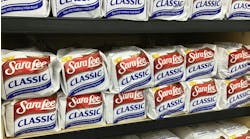Despite comprising a relatively small share of sales at most grocery stores, in-store bakeries are a growing part of the food retailing landscape. And despite their artisanal, made-from-scratch appearance, in-store bakeries rely on food processors to supply them with materials that range from carefully selected raw ingredients to par-baked products to finely crafted desserts.
"In-store bakeries help create and build an image of freshness and quality that carries over throughout the rest of the supermarkets they occupy," says a report from Packaged Facts. They also "support the convenience of one-stop shopping that is so essential for mass merchandisers and warehouse clubs.
"The result of retail’s reliance on in-house bakeries, combined with higher price points, has allowed the in-house baked goods market to experience dollar sales increase every year since 2008," says Packaged Facts, which expects the gains to continue for the foreseeable future.
Mintel Group reports sales for in-store bakeries neared $13 billion in 2018 and are expected to hit $14.5 billion by 2023. "Amid such growth, there is still potential to expand further, as penetration among consumers is somewhat low (just over 50%)," says Mintel analyst William Roberts Jr.
"Key for the category will be expanding beyond its perception as a resource [only] for events and special occasions," he continues. "Expanding use of 'everyday' products like freshly baked breads and other baked goods would fuel further growth. Engaging technology – both in-store and online – can help inform and drive traffic, if not orders. Apps and activating social media campaigns to promote scheduled tastings and events and to encourage fans to share their occasions will keep fans invested."
Those are indeed the keys. Despite some attractive designs and the wonderful smells, the in-store bakery department is not being visited by all grocery store shoppers. Those that do are probably picking up a custom birthday cake or special bread or rolls for a holiday dinner. Therein lies the opportunity.
The International Dairy-Deli-Bakery Association says visitors to the in-store bakery are looking for fresh, healthier and single-serve options, plus ethnic-influenced and indulgent products.
And while the bakery department's overall sales are growing, sales of bakery bread have remained flat and in some cases have declined, according to IDDBA. "What can stores do to buck this trend and grow fresh-baked bread sales?" the association asks, introducing a research report "Total Store Connectivity: Revealing New Pathways to Win with Bakery Breads." IDDBA suggests looking at the natural sales connections bakery bread has with products across the store.
How food processors can help
From simple ingredients like specialty flours leavening agents to pre-fermented dough or par-baked goodies, food processors are key suppliers to in-store bakeries.
"Our extensive line of unique and on-trend desserts, sweet goods and award-winning breads ensure your bakery’s offerings will exceed the demands of today’s shoppers and create a loyal fan-base for tomorrow’s purchases," says Rich Products Corp.'s foodservice business, which has an In-Store Bakery & Deli Division.
Perhaps moreso than grocery retailers, "We have our fingers on the pulse of the industry and your shoppers; we match market data and proprietary intelligence with your needs to deliver personalized solutions to grow your bottom line," says Rich Foodservice.
"The chains we work with, they tell us what they need and we create and deliver the products for them," says Takis Markoutsis, owner and pastry chef at Pasadena Baking Co., Pasadena, Calif. "We can sell them cakes that they can decorate in the store, or par-baked bread or buns that they finish. They don't need to do everything from scratch, really."
The bakery factory
In a way, some observers say, the artisanal nature of baking, and the craftsmanship involved, have had the effect of retarding its progress. Some practitioners just don’t think bakery and automation go together.
“Bakery has always been, I guess you could say, the stepchild of all the other food industries,” says Ken Hagedorn, a vice president with Naegele Inc., a distributor and line integrator. “It’s always been lagging behind because a lot of people think of bakery as more of an art. You’re dealing with a living organism and stuff. But that’s slowly changing.”
The slowness of change means that it happens sometimes through basic, incremental steps. For instance, one way EnSight Solutions helps plants become more efficient is by enabling conveyors to replace troughs of dough wheeled from one point on the line to another. This is not only inefficient but potentially dangerous when troughs bearing a ton of dough get wheeled down an aisle, says EnSight sales specialist Gary Seiffer.
“Through our dough feeding system where we move freshly mixed dough, the dough climbs vertically and uses air space not floor space to move dough to the hopper/chunker,” Seiffer says. “We have had projects where one mixer can feed different production lines via our specialty conveyors.”
Automation can also take hold in unexpected ways. For instance, bakers are finding that they can use EnSight’s Likwifier blenders to grind finished goods that are off-weight or otherwise unsaleable into powder. This powder can be mixed with water to make a slurry that will “stretch” a batch of raw dough. Seiffer says one end user found this process so cost-efficient that he automated it.
“Once you’ve processed it, you have to take it out of the machine to add it to raw dough in a mixer,” Seiffer says. “He was doing it by hand. Now he wants to be able to go to a computer and say, OK, I have 800 pounds of dough, I need 100 pounds of the slurry, push a button, and automatically pump 100 pounds into the raw dough.” The slurry would come either directly from the Likwifier or a surge tank.
Even, consistent depositing of viscous materials is easier with automated systems. Photo: Hinds-Bock
Proper controls are especially important in bakeries because they often deal with highly viscous components and ingredients that have to be deposited evenly. That’s why Hinds-Bock has continued to expand its family of piston and pump filling machines driven with servomotors.
“Because the servomotors are recipe-driven, the end result is having much more control of the delivery and appearance of product, higher yield, increased consistency and less ingredient waste,” says Lance Aasness, Hinds-Bock’s executive vice president. “This is especially important when trying to spread the deposit of a product out laterally and end-to-end.”
Controls are especially useful when bakeries have to vary specs like dough thicknesses when they switch between recipes, Hagedorn says: “The most common reason people get a PLC is to help them have quick changeover. It’s like pressing a button on a dough-sheeting station, and it’ll set the gauging stations automatically, so that you don’t have to adjust what that dough thickness is going to be.”
Another use for automation is handling minor ingredients in a formulation, which is a situation bakeries often face. Components like poppy seeds or sesame seeds can define an SKU, even though they’re used in relatively small quantities. They have to be tracked for accurate use and cleaned from equipment thoroughly to prevent any product confusion or, worse, allergen issues.
“Minor ingredient automation is providing a system that is reliable, accurate, cleanable and easy to use,” says Tom Leach, pneumatic conveying sales manager at Camcorp, a member of the Scheuch Group. “Many of the feeders require clean-in-place design; aeration or mechanical agitation discharge assistance along with various screw diameters and lengths. The advantage of minor ingredient automation is that it replaces manual weighing and improving accuracy.”
As automation marches on in the bakery industry, however, some caution that it shouldn’t leave workers behind. Hagedorn calls it “a double-edged sword.”
“Sometimes I think we get to the point where we’re making the machines so complicated or so computer-literate that they just don’t have the people that really understand how to operate them,” he says.
“Sometimes it’s not a blessing, it’s a curse when you overdo it. It sounds great, I’m doing all this computerization of my machine, but if you don’t have the people that understand it, you’re shooting yourself in the foot.”


